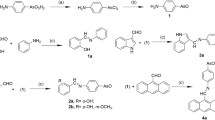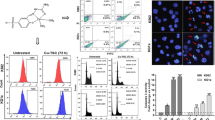Abstract
The purpose of the study was to characterize the involvement of reactive oxygen species (ROS) in mediating the cytotoxic effects of arsenic trioxide (ATO) in combination with sulindac or its metabolites: sulfide (SS) and sulfone (SF) on human leukemic cell lines. Jurkat, HL-60, K562, and HPB-ALL cells were exposed to the drugs alone or in combinations. Cell viability was measured using WST-1 or XTT reduction tests and ROS production by dichlorodihydrofluorescein diacetate staining (flow cytometry). Modulation of (a) intracellular glutathione (GSH) level was done by using l-buthionine sulfoximine (BSO) or diethylmaleate (DEM), (b) NADPH oxidase by using diphenyleneiodonium (DPI), and (c) MAP kinases by using SB202190 (p38), SP600125 (JNK), and U0126 (ERK) inhibitors. ATO cytotoxicity (0.5 or 1 μM) was enhanced by sulindacs, with higher activity showed by the metabolites. Strong cytotoxic effects appeared at SS and SF concentrations starting from 50 μM. The induction of ROS production seemed not to be the major mechanism responsible for the cytotoxicity of the combinations. A strong potentiating effect of BSO on ATO cytotoxicity was demonstrated; DEM (10–300 μM) and DPI (0.0025–0.1 μM; 72 h) did not influence the effects of ATO. Some significant decreases in the viability of the cells exposed to ATO in the presence of MAPK inhibitors comparing with the cells exposed to ATO alone were observed; however, the effects likely resulted from a simple additive cytotoxicity of the drugs. The combinations of ATO with sulindacs offer potential therapeutic usefulness.







Similar content being viewed by others
References
Giovannucci E, Rimm EB, Stampfer MJ, et al. Aspirin use and the risk for colorectal cancer and adenoma in male health professionals. Ann Int Med. 1994;121:241–6.
Giardiello FM, Yang VW, Hylind LM, et al. Primary chemoprevention of familial adenomatous polyposis with sulindac. N Engl J Med. 2002;346:1054–9.
Labayle D, Fischer D, Vielh P, et al. Sulindac causes regression of rectal polyps in familial adenomatous polyposis. Gastroenterology. 1991;101:635–9.
Oshima M, Dinchuk JE, Kargman SL, et al. Suppression of intestinal polyposis in Apc delta716 knockout mice by inhibition of cyclooxygenase 2 (COX-2). Cell. 1996;87:803–9.
Waddell WR, Loughry RW. Sulindac for polyposis of the colon. J Surg Oncol. 1983;24:83–7.
Yamamoto Y, Yin MJ, Lin KM, Gaynor R. Sulindac inhibits activation of NF-κB pathway. J Biol Chem. 1999;274:27307–14.
Shiff SF, Qiao L, Tsai LL, Rigas B. Sulindac sulfide, an aspirin-like compound, inhibits proliferation, causes cell cycle quiescence, and induces apoptosis in HT-29 colon adenocarcinoma cells. J Clin Invest. 1995;96:491–503.
Hanif R, Pittas A, Feng Y, et al. Effects of nonsteroidal anti-inflammatory drugs on proliferation and on induction of apoptosis in colon cancer cells by a prostaglandin-independent pathway. Biochem Pharmacol. 1996;52:237–45.
Han EK, Arber N, Yamamoto H, et al. Effects of sulindac and its metabolites on growth and apoptosis in human mammary epithelial and breast carcinoma cell lines. Breast Cancer Res Treat. 1998;48:195–203.
Rahman MA, Dhar DK, Masunaga R, et al. Sulindac and exisulind exibit a significant antiproliferative effect and induce apoptosis in human hepatocellular carcinoma cell lines. Cancer Res. 2000;60:2085–9.
Lim JTE, Piazza GA, Pamukcu R, et al. Exisulind and related compounds inhibit expression and function of the androgen receptor in human prostate cancer cells. Clin Cancer Res. 2003;9:4972–82.
Piazza GA, Alberts DS, Hixson LJ, et al. Sulindac sulfone inhibits azoxymethane-induced colon carcinogenesis in rats without reducing prostaglandin levels. Cancer Res. 1997;57:2909–15.
Thompson HJ, Briggs S, Paranka NS, et al. Sulfone metabolite of sulindac inhibits mammary carcinonogenesis. J Nat Cancer Inst. 1995;87:1259–60.
Soriano AF, Helfrich B, Chan DC, et al. Synergistic effects of new chemopreventive agents and conventional cytotoxic agents against human lung cancer cell lines. Cancer Res. 1999;59:6178–84.
Chan DC, Earle KA, Zhao TL, et al. Exisulind in combination with docetaxel inhibits growth and metastasis of human lung cancer and prolongs survival in athymic nude rats with orthotopic lung tumors. Clin Cancer Res. 2002;8:904–12.
Whitehead CM, Earle KA, Fetter J, et al. Exisulind-induced apoptosis in a non-small cell lung cancer orthotopic lung tumor model augments docetaxel treatment and contributes to increased survival. Mol Cancer Ther. 2003;2:479–88.
Piazza GA, Rahm AK, Finn TS, et al. Apoptosis primarily accounts for the growth-inhibitory properties of sulindac metabolites and involves a mechanism that is independent of cyclooxygenase inhibition, cell cycle arrest, and p53 induction. Cancer Res. 1997;57:2452–9.
Thompson WJ, Piazza GA, Li H, et al. Exisulind induction of apoptosis involves guanosine 3′, 5′-cyclic monophosphate phosphodiesterase inhibition, protein kinase G activation, and attenuated beta-catenin. Cancer Res. 2000;60:3338–42.
Soh JW, Mao Y, Kim MG, et al. Cyclic GMP mediates apoptosis induced by sulindac derivatives via activation of c-Jun NH2-terminal kinase 1. Clin Cancer Res. 2000;6:4136–41.
Czibere A, Prall WC, Zerbini LF, et al. Exisulind induces apoptosis in advanced myelodysplastic syndrome (MDS) and acute myeloid leukaemia/MDS. Br J Haematol. 2006;135:355–7.
Zhang T, Westervelt P, Hess JL. Pathologic, cytogenetic and molecular assessment of acute promyelocytic leukemia patients treated with arsenic trioxide (As2O3). Mod Pathol. 2000;13:954–61.
Litzow MR. Arsenic trioxide. Expert Opin Pharmacother. 2008;9:1773–85.
Platanias LC. Biological responses to arsenic compounds. J Biol Chem. 2009;284:18583–7.
Chen D, Chan R, Waxman S, Jing Y. Buthionine sulfoximine enhancement of arsenic trioxide-induced apoptosis in leukemia and lymphoma cells is mediated via activation of c-Jun NH2-terminal kinase and up-regulation of death receptors. Cancer Res. 2006;66:11416–23.
Grad JM, Bahlis NJ, Reis I, et al. Ascorbic acid enhances arsenic trioxide-induced cytotoxicity in multiple myeloma cells. Blood. 2001;98:805–13.
Qazilbash MH, Saliba RM, Nieto Y, et al. Arsenic trioxide with ascorbic acid and high-dose melphalan: results of a phase II randomized trial. Biol Blood Marrow Transplant. 2008;14:1401–7.
Roboz GJ, Ritchie EK, Curcio T, et al. Arsenic trioxide and low-dose cytarabine in older patients with untreated acute myeloid leukemia, excluding acute promyelocytic leukemia. Cancer. 2008;113:2504–11.
Jin HO, Yoon SI, Seo SK, et al. Synergistic induction of apoptosis by sulindac and arsenic trioxide in human lung cancer A549 cells via reactive oxygen species-dependent down-regulation of survivin. Biochem Pharmacol. 2006;72:1228–36.
Park JH, Kim EJ, Jang HY, et al. Combination treatment with arsenic trioxide and sulindac enhances apoptotic cell death in lung cancer cells via activation of oxidative stress and mitogen-activated protein kinases. Oncol Rep. 2008;20:379–84.
Jin HO, Seo SK, Woo SH, et al. A combination of sulindac and arsenic trioxide synergistically induces apoptosis in human lung cancer H1299 cells via c-Jun NH2-terminal kinase-dependent Bcl-xL phosphorylation. Lung Cancer. 2008;61:317–27.
Lee HR, Cheong HJ, Kim SJ, et al. Sulindac enhances arsenic trioxide-mediated apoptosis by inhibition of NF-kappaB in HCT116 colon cancer cells. Oncol Rep. 2008;20:41–7.
Jiang TT, Brown SL, Kim JH. Combined effect of arsenic trioxide and sulindac sulfide in A549 human lung cancer cells in vitro. J Exp Clin Cancer Res. 2004;23:259–62.
Stępnik M, Ferlińska M, Smok-Pieniążek A, Gradecka-Meesters D, Arkusz J, Stańczyk M. Sulindac and its metabolites: sulindac sulfide and sulindac sulfone enhance cytotoxic effects of arsenic trioxide on leukemic cell lines. Toxicol Vitro. doi:10.1016/j.tiv.2011.04.011.
IARC Working Group on the Evaluation of Carcinogenic Risks to Humans. Some drinking water disinfectants and contaminants, including arsenic. In: IARC Monographs on the Evaluation of Carcinogenic Risks to Humans, vol 84, France: IARC, Lyon; 2004. p. 228.
Dilda PJ, Hogg PJ. Arsenical-based cancer drugs. Cancer Treat Rev. 2002;33:542–64.
Au WY, Tam S, Fong BM, Kwong YL. Determinants of cerebrospinal fluid arsenic concentration in patients with acute promyelocytic leukemia on oral arsenic trioxide therapy. Blood. 2008;112:3587–90.
Kumana CR, Au WY, Lee NS, et al. Systemic availability of arsenic from oral arsenic-trioxide used to treat patients with hematological malignancies. Eur J Clin Pharmacol. 2002;58:521–6.
Reeder MK, Pamakcu R, Weinstein IB, et al. Select cyclic nucleotide phosphodiesterase inhibitors in colon tumor chemoprevention. In: Gary J, Kelloff ET, Hawk C, Sigman C, editors. Cancer chemoprevention: promising cancer chemopreventive agents. Clifton: Humana Press; 2004. p. 401–18.
Ravis WR, Diskin CJ, Campagna KD, et al. Pharmacokinetics and dialyzability of sulindac and metabolites in patients with end-stage renal failure. J Clin Pharmacol. 1993;33:527–34.
van Stolk R, Stoner G, Hayton WL, et al. Phase I trial of exisulind (sulindac sulfone, FGN-1) as a chemopreventive agent in patients with familial adenomatous polyposis. Clin Cancer Res. 2000;78:78–89.
Chen YC, Lin-Shiau SY, Lin JK. Involvement of reactive oxygen species and caspase activation in arsenite-induced apoptosis. J Cell Physiol. 1998;177:324–33.
Coe E and Schimmer AD. Catalase activity and arsenic sensitivity in acute leukemia. Leuk Lymphoma. 2008;49:1976–81.
Krance SM, Keng PC, Palis J, Ballatori N. Transient glutathione depletion determines terminal differentiation in HL-60 cells. Oxid Med Cell Longev. 2010;3:53–60.
Gao W, Mizukawa Y, Nakatsu N, et al. Mechanism-based biomarker gene sets for glutathione depletion-related hepatotoxicity in rats. Toxicol Appl Pharmacol. 2010. doi:10.1016/j.taap.2010.06.015.
Plummer JL, Smith BR, Sies H, Bend JR. Chemical depletion of glutathione in vivo. Methods Enzymol. 1981;77:50–9.
Griffith OW. Depletion of glutathione by inhibition of biosynthesis. Methods Enzymol. 1981;77:59–63.
Chou WC, Jie C, Kenedy AA, et al. Role of NADPH oxidase in arsenic-induced reactive oxygen species formation and cytotoxicity in myeloid leukemia cells. Proc Natl Acad Sci USA. 2004;101:4578–83.
Smith KR, Klei LR, Barchowsky A. Arsenite stimulates plasma membrane NADPH oxidase in vascular endothelial cells. Am J Physiol Lung Cell Mol Physiol. 2001;280:L442–9.
Wang W, Adachi M, Kawamura R, et al. Parthenolide-induced apoptosis in multiple myeloma cells involves reactive oxygen species generation and cell sensitivity depends on catalase activity. Apoptosis. 2006;11:2225–35.
Wang J, Li L, Cang H, Shi G, Yi J. NADPH oxidase-derived reactive oxygen species are responsible for the high susceptibility to arsenic cytotoxicity in acute promyelocytic leukemia cells. Leuk Res. 2007;32:429–36.
Davison K, Mann K, Waxman S, Miller WH Jr. JNK activation is a mediator of arsenic trioxide-induced apoptosis in acute promyelocytic leukemia cells. Blood. 2004;103:3496–502.
Sánchez Y, Calle C, de Blas E, Aller P. Modulation of arsenic trioxide-induced apoptosis by genistein and functionally related agents in U937 human leukaemia cells. Regulation by ROS and mitogen-activated protein kinases. Chem Biol Interact. 2009;182:37–44.
Kajiguchi T, Yamamoto K, Hossain K, et al. Sustained activation of c-jun-terminal kinase (JNK) is closely related to arsenic trioxide-induced apoptosis in an acute myleoid leukemia (M2)-derived cell line, NKM-1. Leukemia. 2003;17:2189–95.
Kajiguchi T, Yamamoto K, Iida S, et al. Sustained activation of c-jun-N-terminal kinase plays a critical role in arsenic trioxide-induced cell apoptosis in multiple myeloma cell lines. Cancer Sci. 2006;97:540–5.
Potin S, Bertoglio J, Bréard J. Involvement of a Rho-ROCK-JNK pathway in arsenic trioxide-induced apoptosis in chronic myelogenous leukemia cells. FEBS Lett. 2007;581:118–24.
Wen J, Cheng HY, Feng Y, et al. P38 MAPK inhibition enhancing ATO-induced cytotoxicity against multiple myeloma cells. Br J Haematol. 2008;140:169–80.
Ludwig S, Hoffmeyer A, Goebeler M. The stress inducer arsenite activates mitogen-activated protein kinases extracellular signal-regulated kinases 1 and 2 via a MAPK kinase 6/p38-dependent pathway. J Biol Chem. 1998;273:1917–22.
Lunghi P, Giuliani N, Mazzera L, et al. Targeting MEK/MAPK signal transduction module potentiates ATO-induced apoptosis in multiple myeloma cells through multiple signaling pathways. Blood. 2008;112:2450–62.
Acknowledgments
These investigations were supported by grant N N401 2806 33 (agreement 2806/B/P01/2007/33) from the Polish Ministry of Science and Higher Education. The authors thank Mariola Włodarek and Barbara Pawlak for their technical assistance.
Author information
Authors and Affiliations
Corresponding author
Rights and permissions
About this article
Cite this article
Stępnik, M., Ferlińska, M., Smok-Pieniążek, A. et al. Assessment of the involvement of oxidative stress and Mitogen-Activated Protein Kinase signaling pathways in the cytotoxic effects of arsenic trioxide and its combination with sulindac or its metabolites: sulindac sulfide and sulindac sulfone on human leukemic cell lines. Med Oncol 29, 1161–1172 (2012). https://doi.org/10.1007/s12032-011-9920-1
Received:
Accepted:
Published:
Issue Date:
DOI: https://doi.org/10.1007/s12032-011-9920-1




